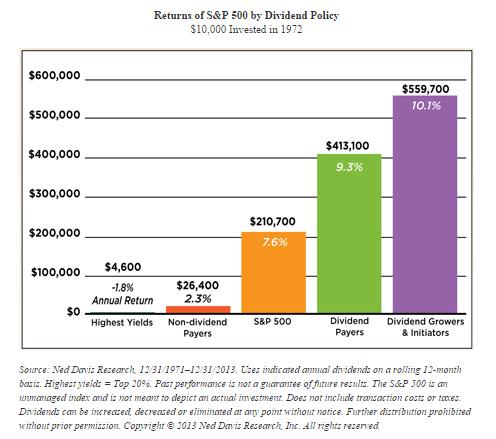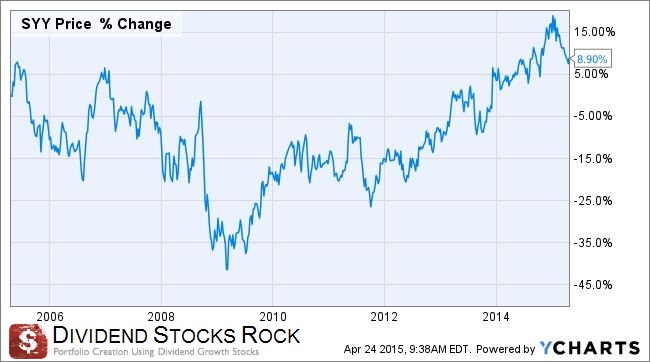
I decided I didn’t have enough from the article I wrote last week about dividend reports. Last week, I knew I was opening a can of worm when I wrote that I don’t understand the importance of tracking my dividend income on a monthly basis. While the discussion was very interesting on this blog, I got crucified for blasphemy on Seeking Alpha when they republished my article (at least they thought it was good enough to be read! Hahaha!). Don’t worry, I’m not going to go back to this post to defend myself, I really don’t mind if some cranky individuals decided to go hard on me. I’m here to take the discussion further about what dividend growth investing is.
What I learned from last week’s post is that defining words you use is very important as we don’t all have the same definition of them. Then I thought about my own definition of dividend growth investing and I realized that my definition probably differs from most “classic” dividend investors’ ideas. Because “dividend growth” is written with three words…
Dividend
The first concept of dividend growth investing is obviously about the precious distribution companies pay their investors. The distribution can be paid monthly or the wait can be as long as yearly, but most stocks pay dividends on a quarterly basis.
Much empirical research has been done during the past 50 years and many of them conclude that dividend paying stocks will ultimately outperform the stock market over a long period of time. This makes total sense when you think about the basics; a dividend is distributed to shareholders only after the company had made a profit and paid its taxes. In fact, if the company has a better usage of the remaining monies, it may not even pay a dividend. By deduction, you can determine that dividend paying stocks must be very strong to post solid profits and generate enough cash flow so it can use some to reward shareholders at the same time as it continues to grow the business. It’s only common sense to think that once you found such company, you can expect it to outperform the overall market.
But intuition is not enough; you need something stronger to convince most people to make a move towards something as serious as an investing strategy. I could pull out ten research articles to show you that dividend investing is a strong investing philosophy, but I’ll share only my favorite graph produced by the Ned Davis Research about stock returns from December 31st 1971 to December 31st 2013:

As you can see, the S&P 500 outperformed the non-dividend payers and the highest dividend yield paying stocks. However, regular dividend payers and dividend growers easily beat the S&P 500 returns.
By choosing dividend investing, you are not automatically guaranteed to beat the market or perform well. It all depends on your investment decisions. However, you are guaranteed to pick your fruit from the best basket. Small cap traders, options gurus and penny stock maniacs could do a lot better than dividend investing, but they can also lose everything in a heartbeat. It is less likely to happen with dividend investing.
The purple column on this chart is related to dividend growers and initiators. Therefore, choosing dividend paying stocks is a good strategy, but picking those which increase their dividend year after year is even better. This leads me to the second word of my dividend growth investing definition:
Related read:
How to build an equal payment monthly dividend portfolio
7 Dividend Investing Principles
My case against high dividend yield stocks
Dividend Growth
I always say that if there is 1 metric I would look at before buying a stock, it is its dividend growth rate. If there is one number you can take a look; check out the dividend growth. When a company is able to grow its dividend over a long periods of time, it implies the following:
A strong business model leading to;
Strong branding & market leadership leading to;
Increasing sale leading to;
Increasing profit leading to;
Increasing cash flow leading to;
Increasing dividends
But don’t take my word for it, take a look at Tetrem Capital’s research with Bloomberg data:
 Source: Dividend Debate
Source: Dividend Debate
As you can see, the dividend growers are always the companies on top of the market. It’s even more important as they didn’t take the same hit the S&P500 took back in 2008 or during the techno bubble in 2000.
Then again, what does it take for a company to increase its dividend over the next 15, 20, 25 years? Solid profit growth. And how do you generate solid profit growth? With an amazing business model. If you take a look at the dividend aristocrats list, you will find that most companies in this list are companies with exceptional branding, leaders of their market and showing a competitive advantage that is almost untouchable.
I know many investors take a look at a company’s previous cash flow generation ability. As dividend investors, we usually prefer cash flow to earnings as the latter is an accounting number and has nothing to do with what lies in the business bank account. Since the dividend is taken directly from the bank account, cash flow is king. But you can avoid being so concerned about cash flow generation once you find a company with a perfect dividend growth tracking record. It implies that cash flow is generated within the company. This is why I like dividend growth so much; it makes investing so much simpler.
Unfortunately, it doesn’t mean you have to disregard other metrics or simply focus on dividend payment and dividend growth.
There is also a hidden trap in the dividend investing concept and this is where I think many investors forget about the forest behind the three.
I’m cherry picking here, but I want to show you that dividend growth is not everything. Take Sysco (SYY), a strong dividend aristocrat. This is a strong and diversified company increasing its dividend payment since the 70s. But over the past 10 years, the stock value barely moved leaving investors with the dividend growth and… nothing else.

This is why it is important not to forget about the third word in “dividend growth” which is… growth.
Related read:
How to build a double digit dividend growth portfolio
Growth
As a dividend investor, I don’t stop at the dividend payment (yield) or the dividend growth. I also look at the overall potential of the stock growth in the future. I’ve been criticized of not being a true “dividend investor”; I’ve even been called a “trader” because I focus on stock value appreciation. Just to make sure we are clear on something; a trader is an investor actively buying and selling stocks in his portfolio; I do about 4 trades per year.
Each and every single stock I buy must pay a dividend. This is my first search criteria. However, I’m not blinded by a juiced up dividend. The company must show general growth perspective. If it doesn’t, some day or another, the dividend growth will stop. This is why I focus on capital appreciation.
In order to manage properly my dividend portfolio, I’ve divided it into two different segments: The Core and The Growth part.

The core section is follows exactly the buy & hold dividend growth style. I pick companies I will likely hold forever. In the core section, I have the following holdings:
Apple (AAPL)
Coca-Cola (KO)
Walt Disney (DIS)
Johnson & Johnson (JNJ)
Telus (T.TO)
Walmart (WMT)
National Bank (NA.TO)
Lockheed Martin (LMT)
These are companies I want to keep and benefit from their strong dividend growth. This is my cushion, the foundation of my portfolio. However, some of these holdings won’t produce astonishing returns if you exclude the dividend. I’m thinking of Walmart for example, it evolves in a mature market and their margins are very small. This is why I also include a growth portion of my portfolio including the following holdings:
Black Diamond Group (BDI.TO)
Gluskin Sheff (GS.TO)
Helmerich & Payne (HP)
SNC Lavalin (SNC.TO)
As you can see, this is a smaller portion of my portfolio. The growth part is riskier and includes higher volatility. I bought BDI.TO during the oil turmoil; the stock is now up and keeps paying a very high dividend. I bought GS.TO hoping for a future merger/acquisition as there is a consolidation trend among the private wealth industry. HP was bought to benefit from the oil boom (before it collapsed), so far, it is my only negative holding in my whole portfolio. Finally, I bought SNC.TO recently to benefit of a recent stock price drop (due to fraud allegations).
These trades seems more like what a trader would do, but if you look closer at each of these companies, you will find solid business models and dividend being paid and increased regularly. I expect to hold these companies for an 18 – 24 month period until I can realize a quick capital gain.
Sometimes, a stock bought for the “growth” segment turns out to be a great pick and moves into the core portfolio. My most recent example is APPL. I bought the stock before the split, when it was trading around $440 (it went down to close to $400 if I remember correctly). Nothing was going well with AAPL, sales were down, competition was up; I thought it was the perfect time to buy it. Today, many problems have been resolved and AAPL continues to grow its “perfect” product ecosystem with Apple Pay and the iWatch. I now expect to hold AAPL for several years.
On the other hand, I recently sold MCD and BNS.TO because I was disappointed in their efforts to grow their businesses. They were both part of my core portfolio. As you can see, following your holdings closely is crucial. I have a simple selling rule that I always follow:
Sell a stock the minute it no longer shows the reasons you bought it in the first place.
Because the world is on the fast track ever evolving, because companies rise and die in a heartbeat, following your holdings on a quarterly basis helps you generate strong results. It is true that I’m selling stocks more often than regular dividend investors, but that’s probably because I see three words in Dividend Growth.
Related read:
My investing philosophy: Core & Growth portfolios
Disclaimer: I do not hold shares of SYY
Image credit
